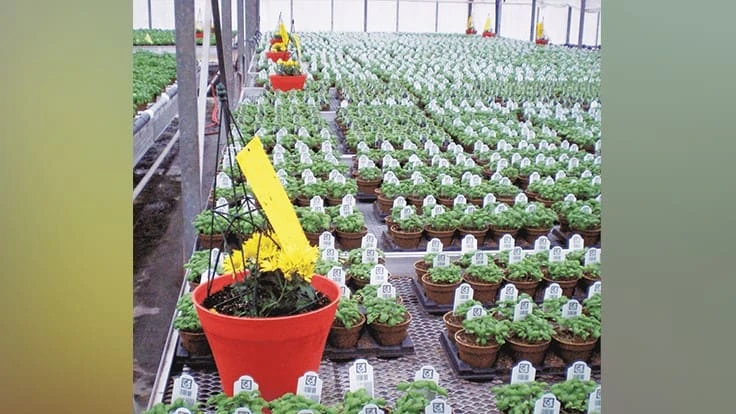

Non-crop plants can help growers scout, remove and control pests, aiding in pest control and reducing chemical applications, often working together. “I see it as a big continuum,” says Dr. Rose Buitenhuis, research scientist, biological control, Vineland Research and Innovation Centre.
Greenhouse Management picked up some tips and tricks to using each from Buitenhuis, a research scientist who specializes in biological control and integrated pest management of insect and mite pests.
Indicator plants — These are plants that are more attractive to pests than the main crop in a greenhouse, so that’s where a pest or a disease will show up first. The focus for these is monitoring. “And most growers know, for example, if I get thrips, they’ll show up on this variety first,” she says. “If you only use it for monitoring, that’s when it’s almost like a living sticky card almost.”
Examples: Petunias and fava beans for thrips
Trap plants — When your aim is to remove pests from your production system, it then becomes a trap plant. Trap plants can be part of a biocontrol system or a chemical control system. “I say that every pest you trap is one less that can go and reproduce,” Buitenhuis says. “That goes for any pest management program that you have if it's chemical-based or bio-based.”
Trap plants require constant observation. For example, if you leave a chrysanthemum plant out and the thrips flock to it, as soon as the flowers start to age, the thrips will see it as a depletion of resources and search for another resource. But by that time, the thrips will have reproduced.
“So you really have to make sure that you remove the trap plants regularly from the greenhouse,” she says.
As with any pest-infested material, bag it and immediately destroy it away from your greenhouse.
Examples: Flowering mums and gerbera for whitefly, beans for spider mites
Banker plants — These plants provide resources and breeding places for biological control insects. The non-pest prey species will then disperse into the greenhouse to look for other pests. “So they become little biocontrol factories,” Buitenhuis says. “That’s kind of the other end of the spectrum. So you’re maybe not as interested in attracting the pests out of the crop. It’s more that you’re putting in plants that will breed bios for you over a long period of time.”
Examples: Oat and wheat for aphids, ornamental peppers or castor beans for thrips, mullein for whitefly
Placing plants
“Hopefully from a greenhouse scouting program, they know where the trouble spots are, so I would definitely put them in there as an early warning system to be able to catch more of the pest out of the crop,” Buitenhuis says. “Also to be able to catch more of the pests out of the crop.”
Once pests have settled on a crop, they’re not going to go looking for a more appetizing location, she says. Put trap plants where pests are moving around. For example, side vents, doorways and in between infested and non-infested crops.
“For thrips in particular, put them any place where thrips are on the move because then they will perceive an interesting plant and they have to choose: land on the crop or land on the trap plants. And they'll definitely go to the trap plant,” Buitenhuis says. “But once they're on your crop, they're not really going to leave because that's kind of an uncertain scenario for them.”
While each plant serves its own purpose, they’re all compatible with each other, Buitenhuis says.

Explore the March 2020 Issue
Check out more from this issue and find your next story to read.
Latest from Greenhouse Management
- Anthura acquires Bromelia assets from Corn. Bak in Netherlands
- Top 10 stories for National Poinsettia Day
- Langendoen Mechanical hosts open house to showcase new greenhouse build
- Conor Foy joins EHR's national sales team
- Pantone announces its 2026 Color of the Year
- Syngenta granted federal registration for Trefinti nematicide/fungicide in ornamental market
- A legacy of influence
- HILA 2025 video highlights: John Gaydos of Proven Winners





